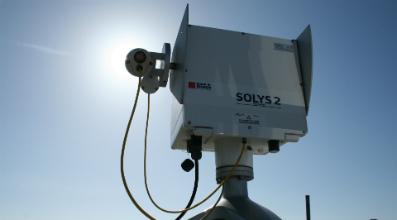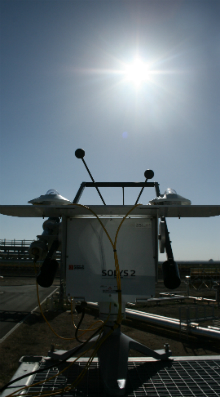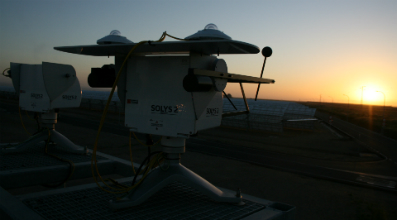Sun Tracker
The fundamental component of a solar monitoring station is a sun tracker such as our SOLYS 2. It automatically points at the sun from sunrise to sunset thanks to its integrated GPS receiver and accurate sun position algorithm. This way the sun tracker makes sure that all the instruments mounted on it are in the optimum position to accurately measure DNI, DHI and GHI.
Pyrheliometer
To measure DNI the solar monitoring station includes a pyrheliometer. With an opening angle of 5 degrees and accurately pointed at the sun, it captures only the direct radiation. Concentrated Solar Power Systems, CSP and CPV, use mainly the direct part of the solar radiation. Our CHP 1 and SHP1 pyrheliometers measure daily totals of solar irradiance according to ISO 9060 First Class.

Pyranometers
 The sun tracker usually has two pyranometers mounted on top of it. One to measure the global horizontal irradiance and one for diffuse horizontal irradiance. To measure the diffuse part, the solar monitoring station has a shading assembly fitted to shade the dome of one pyranometer so that direct radiation is blocked. Our CMP 11 Secondary Standard pyranometer is most commonly used in solar energy and can be found on solar monitoring stations around the world. Our new CMP10 low maintenance pyranometer, in combination with the new CVF4 ventilation unit, offers the longest maintenance interval available.
The sun tracker usually has two pyranometers mounted on top of it. One to measure the global horizontal irradiance and one for diffuse horizontal irradiance. To measure the diffuse part, the solar monitoring station has a shading assembly fitted to shade the dome of one pyranometer so that direct radiation is blocked. Our CMP 11 Secondary Standard pyranometer is most commonly used in solar energy and can be found on solar monitoring stations around the world. Our new CMP10 low maintenance pyranometer, in combination with the new CVF4 ventilation unit, offers the longest maintenance interval available.
Optional pyrgeometers and ventilation units
The above forms a basic solar monitoring station. You can choose to add pyrgeometers to measure far infrared long-wave radiation from the sky and ground and a downward looking pyranometer to measure reflected solar radiation and calculate the Albedo of the surface. This creates a complete meteorological or climate monitoring station. Please contact us to learn about the possible configurations we can offer from a basic solar monitoring system to a complete turnkey BSRN station (Baseline Surface Radiation Network), as used in climatology.
Ventilation of pyranometers and pyrgeometers improves the reliability and accuracy of the measurement by reducing dust on the dome, removing dew and rain droplets and melting frost and snow, which would otherwise affect the measurement. Areas where the incoming solar radiation is favourable for solar energy are often dry and dusty, or sandy, and we advise equipping your solar monitoring station with ventilation units.
Why choose a solar monitoring station?
Good quality, reliable radiation data is extremely important for all activities in the solar energy sector. Real-time accurately measured irradiance helps to monitor the system performance. A solar monitoring station is often deployed to evaluate a possible site location for investors to verify the bankability of the installation. It provides input for technology research, quality control, system type selection, maintenance scheduling, operating efficiency monitoring and output forecasting.
For references and application examples please refer to the applications sections of our website.
